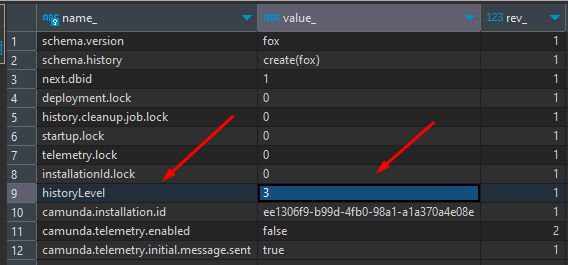mks27
November 7, 2023, 3:41pm
1
Hello Team,
We have upgraded camunda from 7.10 to 7.19 and DB migration scripts also executed.
Camunda engine is running but we are seeing below error.
07-Nov-2023 17:15:52.869 SEVERE [main] org.camunda.commons.logging.BaseLogger.logError ENGINE-16004 Exception while closing command context: ENGINE-03053 History is not enabled.
org.camunda.bpm.engine.ProcessEngineException: ENGINE-03053 History is not enabled.
at org.camunda.bpm.engine.impl.db.EnginePersistenceLogger.disabledHistoryException(EnginePersistenceLogger.java:484)
at org.camunda.bpm.engine.impl.persistence.AbstractHistoricManager.checkHistoryEnabled(AbstractHistoricManager.java:39)
at org.camunda.bpm.engine.impl.persistence.entity.CommentManager.insert(CommentManager.java:46)
=============
2nd error is.
07-Nov-2023 18:15:20.092 SEVERE [http-nio-8080-exec-9] org.camunda.commons.logging.BaseLogger.logError ENGINE-16004 Exception while closing command context: Cannot correlate message ‘ACTIVATION_COMPLETE’: No process definition or execution matches the parameters
org.camunda.bpm.engine.MismatchingMessageCorrelationException: Cannot correlate message ‘ACTIVATION_COMPLETE’: No process definition or execution matches the parameters
at org.camunda.bpm.engine.impl.cmd.CorrelateMessageCmd.execute(CorrelateMessageCmd.java:88)
at org.camunda.bpm.engine.impl.cmd.CorrelateMessageCmd.execute(CorrelateMessageCmd.java:42)
at org.camunda.bpm.engine.impl.interceptor.CommandExecutorImpl.execute(CommandExecutorImpl.java:28)
Please provide your help.
Hello my friend!
The first error means that your history is not enabled on camunda…
In application.properties you can configure the history level as you wish.
camunda.bpm.history-level=FULL
Don’t forget to change it in the database, in the ACT_GE_PROPERTY table in the “historyLevel” field in which the “value” must be 3 if your application.properties is defined as FULL.
The second error means that Camunda is not recognizing this message Correlation… probably you must have some message correction in Camunda, in which the instance is not in the necessary place when the correlation is triggered, or speaking in other words, the correlation does not exist or the instance is not in the necessary scope to receive the correlation.
William Robert Alves
mks27
November 8, 2023, 6:48am
3
Thanks William for response, we are getting few more errors.
07-Nov-2023 17:15:52.961 SEVERE [main] org.apache.catalina.core.StandardContext.startInternal One or more listeners failed to start. Full details will be found in the appropriate container log file
07-Nov-2023 17:15:52.962 SEVERE [main] org.apache.catalina.core.StandardContext.startInternal Context [/camunda-invoice] startup failed due to previous errors
Kindly help us in these also.
Hi \o!
After migrating to version 7.19, did you search the documentation for possible other necessary updates?
Like Java version, spring version, compatible database version, compatible dependencies, etc…?
William Robert Alves
mks27
November 8, 2023, 2:45pm
5
Hello,
We are using Camunda as a microservice and pulling docker image for 7.19.0 , it has all the updated versions.
mks27
November 8, 2023, 3:04pm
6
and we are connecting to new DB on mysql8
Can u show me your configuration in web.xml file?
mks27
November 8, 2023, 4:01pm
8
Hello William,
Please find below web.xml file.
camunda-service-13-w4b45:~/webapps/camunda/WEB-INF$ pwd
/camunda/webapps/camunda/WEB-INF
camunda-service-13-w4b45:~/webapps/camunda/WEB-INF$
camunda-service-13-w4b45:~/webapps/camunda/WEB-INF$ cat web.xml
<?xml version="1.0" encoding="UTF-8"?>
<web-app
version="3.0"
xmlns="http://java.sun.com/xml/ns/javaee"
xmlns:xsi="http://www.w3.org/2001/XMLSchema-instance"
xsi:schemaLocation="http://java.sun.com/xml/ns/javaee http://java.sun.com/xml/ns/javaee/web-app_3_0.xsd">
<display-name>Camunda Platform webapp</display-name>
<!-- cockpit bootstrap listener -->
<listener>
<listener-class>org.camunda.bpm.cockpit.impl.web.bootstrap.CockpitContainerBootstrap</listener-class>
</listener>
<!-- admin bootstrap listener -->
<listener>
<listener-class>org.camunda.bpm.admin.impl.web.bootstrap.AdminContainerBootstrap</listener-class>
</listener>
<!-- tasklist bootstrap listener -->
<listener>
<listener-class>org.camunda.bpm.tasklist.impl.web.bootstrap.TasklistContainerBootstrap</listener-class>
</listener>
<!-- welcome bootstrap listener -->
<listener>
<listener-class>org.camunda.bpm.welcome.impl.web.bootstrap.WelcomeContainerBootstrap</listener-class>
</listener>
<!-- http session mutex listener -->
<listener>
<listener-class>org.camunda.bpm.webapp.impl.security.filter.util.HttpSessionMutexListener</listener-class>
</listener>
<session-config>
<cookie-config>
<http-only>true</http-only>
<secure>false</secure>
</cookie-config>
</session-config>
<!-- Container Based Authentication filter -->
<!-- <filter>
<filter-name>Container Based Authentication Filter</filter-name>
<filter-class>org.camunda.bpm.webapp.impl.security.auth.ContainerBasedAuthenticationFilter</filter-class>
<init-param>
<param-name>authentication-provider</param-name>
<param-value>org.camunda.bpm.engine.rest.security.auth.impl.ContainerBasedAuthenticationProvider</param-value>
</init-param>
</filter>
<filter-mapping>
<filter-name>Container Based Authentication Filter</filter-name>
<url-pattern>/*</url-pattern>
<dispatcher>REQUEST</dispatcher>
</filter-mapping> -->
<!-- Authentication filter -->
<filter>
<filter-name>Authentication Filter</filter-name>
<filter-class>org.camunda.bpm.webapp.impl.security.auth.AuthenticationFilter</filter-class>
<!-- See https://docs.camunda.org/manual/latest/webapps/shared-options/authentication/#cache -->
<init-param>
<param-name>cacheTimeToLive</param-name>
<param-value>300000</param-value>
</init-param>
</filter>
<filter-mapping>
<filter-name>Authentication Filter</filter-name>
<url-pattern>/*</url-pattern>
<dispatcher>REQUEST</dispatcher>
</filter-mapping>
<!-- Security filter -->
<filter>
<filter-name>SecurityFilter</filter-name>
<filter-class>org.camunda.bpm.webapp.impl.security.filter.SecurityFilter</filter-class>
<init-param>
<param-name>configFile</param-name>
<param-value>/WEB-INF/securityFilterRules.json</param-value>
</init-param>
</filter>
<filter-mapping>
<filter-name>SecurityFilter</filter-name>
<url-pattern>/*</url-pattern>
<dispatcher>REQUEST</dispatcher>
</filter-mapping>
<!-- CSRF Prevention filter -->
<filter>
<filter-name>CsrfPreventionFilter</filter-name>
<filter-class>org.camunda.bpm.webapp.impl.security.filter.CsrfPreventionFilter</filter-class>
<!--<init-param>-->
<!--<param-name>targetOrigin</param-name>-->
<!--<param-value>http://localhost:8080</param-value>-->
<!--</init-param>-->
</filter>
<filter-mapping>
<filter-name>CsrfPreventionFilter</filter-name>
<url-pattern>/*</url-pattern>
</filter-mapping>
<!-- Session Cookie filter -->
<filter>
<filter-name>SessionCookieFilter</filter-name>
<filter-class>org.camunda.bpm.webapp.impl.security.filter.SessionCookieFilter</filter-class>
<!--<init-param>-->
<!--<param-name>enableSecureCookie</param-name>-->
<!--<param-value>true</param-value>-->
<!--</init-param>-->
</filter>
<filter-mapping>
<filter-name>SessionCookieFilter</filter-name>
<url-pattern>/*</url-pattern>
</filter-mapping>
<!-- HTTP Header Security Filter -->
<filter>
<filter-name>HttpHeaderSecurity</filter-name>
<filter-class>org.camunda.bpm.webapp.impl.security.filter.headersec.HttpHeaderSecurityFilter</filter-class>
<!--
The Strict Transport Security header is disabled by default.
You can enable it by uncommenting the configuration below.
Read more about it in the documentation
https://docs.camunda.org/manual/latest/webapps/shared-options/header-security/#strict-transport-security
-->
<!--
<init-param>
<param-name>hstsDisabled</param-name>
<param-value>false</param-value>
</init-param>
-->
</filter>
<filter-mapping>
<filter-name>HttpHeaderSecurity</filter-name>
<url-pattern>/*</url-pattern>
<dispatcher>REQUEST</dispatcher>
</filter-mapping>
<!-- Empty body filter -->
<filter>
<filter-name>EmptyBodyFilter</filter-name>
<filter-class>org.camunda.bpm.engine.rest.filter.EmptyBodyFilter</filter-class>
</filter>
<filter-mapping>
<filter-name>EmptyBodyFilter</filter-name>
<url-pattern>/api/*</url-pattern>
</filter-mapping>
<!-- REST cache control filter -->
<filter>
<filter-name>CacheControlFilter</filter-name>
<filter-class>org.camunda.bpm.engine.rest.filter.CacheControlFilter</filter-class>
</filter>
<filter-mapping>
<filter-name>CacheControlFilter</filter-name>
<url-pattern>/api/*</url-pattern>
</filter-mapping>
<!-- engines filter -->
<filter>
<filter-name>Engines Filter</filter-name>
<filter-class>org.camunda.bpm.webapp.impl.engine.ProcessEnginesFilter</filter-class>
</filter>
<filter-mapping>
<filter-name>Engines Filter</filter-name>
<url-pattern>/app/*</url-pattern>
<dispatcher>REQUEST</dispatcher>
</filter-mapping>
<!-- cockpit rest api -->
<servlet>
<servlet-name>Cockpit Api</servlet-name>
<servlet-class>org.jboss.resteasy.plugins.server.servlet.HttpServletDispatcher</servlet-class>
<init-param>
<param-name>javax.ws.rs.Application</param-name>
<param-value>org.camunda.bpm.cockpit.impl.web.CockpitApplication</param-value>
</init-param>
<init-param>
<param-name>resteasy.servlet.mapping.prefix</param-name>
<param-value>/api/cockpit</param-value>
</init-param>
</servlet>
<servlet-mapping>
<servlet-name>Cockpit Api</servlet-name>
<url-pattern>/api/cockpit/*</url-pattern>
</servlet-mapping>
<!-- admin rest api -->
<servlet>
<servlet-name>Admin Api</servlet-name>
<servlet-class>org.jboss.resteasy.plugins.server.servlet.HttpServletDispatcher</servlet-class>
<init-param>
<param-name>javax.ws.rs.Application</param-name>
<param-value>org.camunda.bpm.admin.impl.web.AdminApplication</param-value>
</init-param>
<init-param>
<param-name>resteasy.servlet.mapping.prefix</param-name>
<param-value>/api/admin</param-value>
</init-param>
</servlet>
<servlet-mapping>
<servlet-name>Admin Api</servlet-name>
<url-pattern>/api/admin/*</url-pattern>
</servlet-mapping>
<!-- tasklist rest api -->
<servlet>
<servlet-name>Tasklist Api</servlet-name>
<servlet-class>org.jboss.resteasy.plugins.server.servlet.HttpServletDispatcher</servlet-class>
<init-param>
<param-name>javax.ws.rs.Application</param-name>
<param-value>org.camunda.bpm.tasklist.impl.web.TasklistApplication</param-value>
</init-param>
<init-param>
<param-name>resteasy.servlet.mapping.prefix</param-name>
<param-value>/api/tasklist</param-value>
</init-param>
</servlet>
<servlet-mapping>
<servlet-name>Tasklist Api</servlet-name>
<url-pattern>/api/tasklist/*</url-pattern>
</servlet-mapping>
<!-- engine rest api (embedded) -->
<servlet>
<servlet-name>Engine Api</servlet-name>
<servlet-class>org.jboss.resteasy.plugins.server.servlet.HttpServletDispatcher</servlet-class>
<init-param>
<param-name>javax.ws.rs.Application</param-name>
<param-value>org.camunda.bpm.webapp.impl.engine.EngineRestApplication</param-value>
</init-param>
<init-param>
<param-name>resteasy.servlet.mapping.prefix</param-name>
<param-value>/api/engine</param-value>
</init-param>
</servlet>
<servlet-mapping>
<servlet-name>Engine Api</servlet-name>
<url-pattern>/api/engine/*</url-pattern>
</servlet-mapping>
<!-- welcome rest api -->
<servlet>
<servlet-name>Welcome Api</servlet-name>
<servlet-class>org.jboss.resteasy.plugins.server.servlet.HttpServletDispatcher</servlet-class>
<init-param>
<param-name>javax.ws.rs.Application</param-name>
<param-value>org.camunda.bpm.welcome.impl.web.WelcomeApplication</param-value>
</init-param>
<init-param>
<param-name>resteasy.servlet.mapping.prefix</param-name>
<param-value>/api/welcome</param-value>
</init-param>
</servlet>
<servlet-mapping>
<servlet-name>Welcome Api</servlet-name>
<url-pattern>/api/welcome/*</url-pattern>
</servlet-mapping>
<!-- default error page -->
<error-page>
<!-- Missing resource -->
<error-code>404</error-code>
<location>/error-404-page.html</location>
</error-page>
<error-page>
<!-- Uncaught exception -->
<error-code>500</error-code>
<location>/error-500-page.html</location>
</error-page>
</web-app>
I’m trying to understand but it’s still confusing to me…
Have you checked if the environment variables are correct in your docker?
See if you can check your tomcat logs by searching for the words “ERROR” or “SEVERE”…
William Robert Alves
mks27
November 9, 2023, 12:55am
10
Hello William,
Environment variables are correct and Camunda engine is also started and working but we see these error in the logs.
